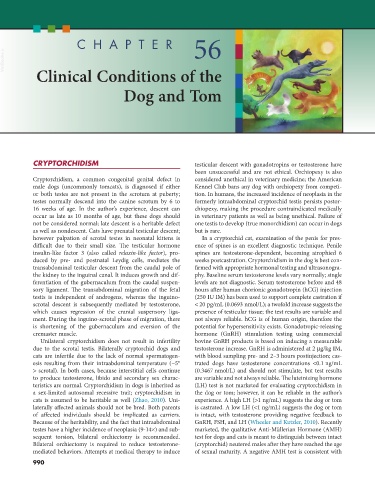Page 1018 - Small Animal Internal Medicine, 6th Edition
P. 1018
990 PART VIII Reproductive System Disorders
CHAPTER 56
VetBooks.ir
Clinical Conditions of the
Dog and Tom
CRYPTORCHIDISM testicular descent with gonadotropins or testosterone have
been unsuccessful and are not ethical. Orchiopexy is also
Cryptorchidism, a common congenital genital defect in considered unethical in veterinary medicine; the American
male dogs (uncommonly tomcats), is diagnosed if either Kennel Club bans any dog with orchiopexy from competi-
or both testes are not present in the scrotum at puberty; tion. In humans, the increased incidence of neoplasia in the
testes normally descend into the canine scrotum by 6 to formerly intraabdominal cryptorchid testis persists postor-
16 weeks of age. In the author’s experience, descent can chiopexy, making the procedure contraindicated medically
occur as late as 10 months of age, but these dogs should in veterinary patients as well as being unethical. Failure of
not be considered normal; late descent is a heritable defect one testis to develop (true monorchidism) can occur in dogs
as well as nondescent. Cats have prenatal testicular descent; but is rare.
however palpation of scrotal testes in neonatal kittens is In a cryptorchid cat, examination of the penis for pres-
difficult due to their small size. The testicular hormone ence of spines is an excellent diagnostic technique. Penile
insulin-like factor 3 (also called relaxin-like factor), pro- spines are testosterone-dependent, becoming atrophied 6
duced by pre- and postnatal Leydig cells, mediates the weeks postcastration. Cryptorchidism in the dog is best con-
transabdominal testicular descent from the caudal pole of firmed with appropriate hormonal testing and ultrasonogra-
the kidney to the inguinal canal. It induces growth and dif- phy. Baseline serum testosterone levels vary normally; single
ferentiation of the gubernaculum from the caudal suspen- levels are not diagnostic. Serum testosterone before and 48
sory ligament. The transabdominal migration of the fetal hours after human chorionic gonadotropin (hCG) injection
testis is independent of androgens, whereas the inguino- (250 IU IM) has been used to support complete castration if
scrotal descent is subsequently mediated by testosterone, < 20 pg/mL (0.0693 nmol/L); a twofold increase suggests the
which causes regression of the cranial suspensory liga- presence of testicular tissue; the test results are variable and
ment. During the inguino-scrotal phase of migration, there not always reliable. hCG is of human origin, therefore the
is shortening of the gubernaculum and eversion of the potential for hypersensitivity exists. Gonadotropic-releasing
cremaster muscle. hormone (GnRH) stimulation testing using commercial
Unilateral cryptorchidism does not result in infertility bovine GnRH products is based on inducing a measurable
due to the scrotal testis. Bilaterally cryptorchid dogs and testosterone increase. GnRH is administered at 2 µg/kg IM,
cats are infertile due to the lack of normal spermatogen- with blood sampling pre- and 2–3 hours postinjection; cas-
esis resulting from their intraabdominal temperature (~5° trated dogs have testosterone concentrations <0.1 ng/mL
> scrotal). In both cases, because interstitial cells continue (0.3467 nmol/L) and should not stimulate, but test results
to produce testosterone, libido and secondary sex charac- are variable and not always reliable. The luteinizing hormone
teristics are normal. Cryptorchidism in dogs is inherited as (LH) test is not marketed for evaluating cryptorchidism in
a sex-limited autosomal recessive trait; cryptorchidism in the dog or tom; however, it can be reliable in the author’s
cats is assumed to be heritable as well (Zhao, 2010). Uni- experience. A high LH (>1 ng/mL) suggests the dog or tom
laterally affected animals should not be bred. Both parents is castrated. A low LH (<1 ng/mL) suggests the dog or tom
of affected individuals should be implicated as carriers. is intact, with testosterone providing negative feedback to
Because of the heritability, and the fact that intraabdominal GnRH, FSH, and LH (Wheeler and Kutzler, 2010). Recently
testes have a higher incidence of neoplasia (9-14×) and sub- marketed, the qualitative Anti-Müllerian Hormone (AMH)
sequent torsion, bilateral orchiectomy is recommended. test for dogs and cats is meant to distinguish between intact
Bilateral orchiectomy is required to reduce testosterone- (cryptorchid) neutered males after they have reached the age
mediated behaviors. Attempts at medical therapy to induce of sexual maturity. A negative AMH test is consistent with
990

